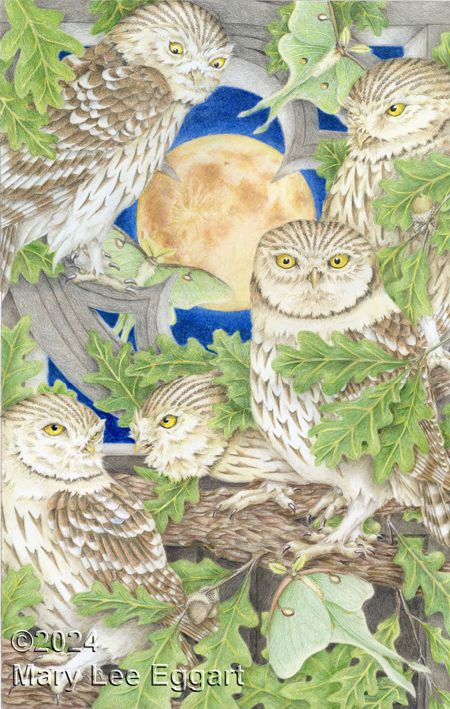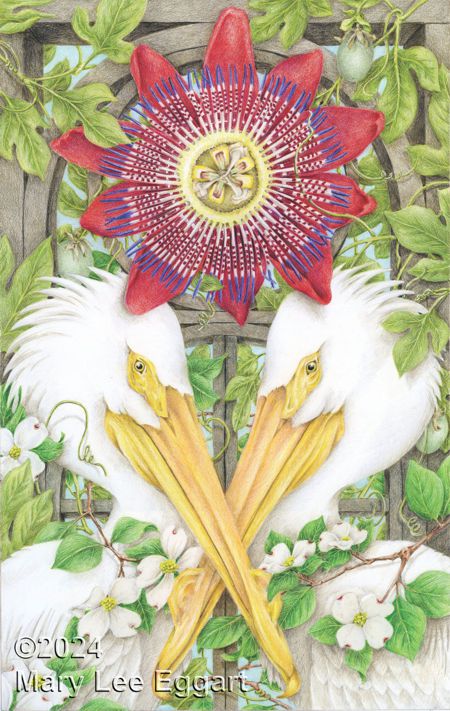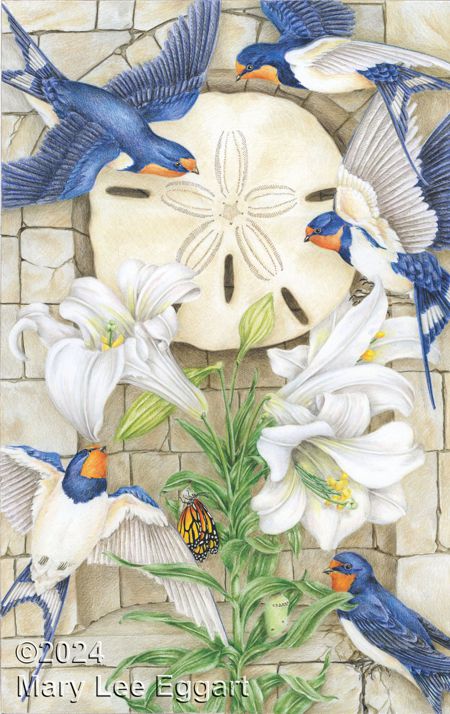Sacrament
colored pencil
10" x 16"
2024
Eucharistic Adoration is a form of contemplative prayer in the Catholic Church in which the consecrated communion host is placed in a vessel (a “monstrance”) as a focus for meditation. The faithful experience unity with the living presence of Christ and strive to be a conduit of His love, light, hope, and grace to the world.
My artwork is inspired by the beauty of creation and I often visualize images of nature during meditation. Like the Medieval artists who found God in nature, I use these images as metaphors to express the insights to which meditation leads. The composition of each drawing reflects the form of the monstrance: a round object held aloft for contemplation.
|
 |
| Sacrament |
| |
For the inaugural drawing of this series, I chose to render the monstrance belonging to my church, Sacred Heart of Jesus in Baton Rouge. A monstrance (from the Latin “to show”) is a vessel, usually made of precious metals and ornately decorated, in which the consecrated Host is displayed for the adoration of the faithful. While the majority of monstrances display the host in a sunburst design, Sacred Heart’s unique vessel is in the shape of a blossoming flower, representing the Rod of Jesse. Jesse was the father of King David. From this Hebrew root sprang a rod, representing the Virgin Mary, and from the rod came a beautiful flower, Jesus Christ.
Surrounding the monstrance are grape vines, representing both the Eucharist and those who believe in Christ. The ringed-neck turtledoves symbolize faithfulness and the souls of the faithful. |
|
 |
Light |
| |
|
Jesus taught “I am the light of the world. Whoever follows me will not walk in darkness, but will have the light of life.” (John 8:12) The sunflower represents the life-giving light of the sun. The morning glory flowers greet the dawn. The brilliant red color of the cardinals symbolizes both love and the vitality of faith. One of the earliest visual depictions of Christ shows Him as Helios, the Greek God of the Sun, represented in this drawing by the protesilaus helios butterfly. |
|
 |
| Love |
| |
The pomegranate that has been cut open symbolizes Christian love, which is open to the needs of all people. It is surrounded by a crown of thorns representing Christ's sacrifice. Together, they form an image reminiscent of His Sacred Heart, the icon of His infinite love.
Ancient writers saw the shape of the ibis in Egyptian hieroglyphics as resembling a heart. In Christian iconography the ibis represents hope and change. Ivy, with its heart-shaped leaves indicates love and because it clings to a host plant also symbolizes fidelity and devotion. The red color of the Blood-red Glider butterfly of Africa emphasizes the theme of love. |
|

|
| Hope |
| |
A bird’s nest with eggs represents potential, growth and hope. It is accompanied here by robins and Louisiana iris, both harbingers of spring and new life.
The anchor is an early Christian symbol of hope, from St. Paul’s epistle to the Hebrews (6:19): “Which hope we have as an anchor of the soul, both sure and steadfast.” Surrounding it is the South American anchor plant (Colletia paradoxa). |
|
 |
| Grace |
| |
Grace is God’s gift of love that invites us into relationship with Him. Because the lotus flower emerges from the darkness under water into the light, it represents the soul transcending the material world. Transcendence is further symbolized by the ethereal great egret. The seashell is a sign of baptism, when we first encounter God’s grace. The dragonfly, which changes from a nymph in the water to a graceful flyer, signifies transformation and renewal. |
|
 |
| Wisdom |
| |
Since prehistoric times, the moon has been seen as a symbol of wisdom and guidance. Because its light is reflective, it can represent the intuitive knowledge we find within our hearts. The lunar theme is emphasized by the luminescent luna moths.
The little owl (Athene Noctua) accompanied the Greek goddess of wisdom Athena, and thus was the association of owls and wisdom established.
In ancient cultures, the oak tree was a source of wisdom, with the acorn containing the knowledge of the universe. |
|
 |
Sacrifice |
| |
Jesus’s sacrifice on the cross exemplified His teaching that there is no greater love than to lay down one’s life for one’s friends.
The parts of the Passion vine are symbolic of the Passion of the Christ: the flower’s spikes protruding from the center resemble the crown of thorns. There are 10 petals, for the 10 faithful apostles. Three stigmata represent the three nails and five anthers represent the five wounds. The flower’s trailing tendrils are similar to whips. The red color of this variety reflects the blood that was shed.
The pelican, which was once believed to feed its chicks with its own blood, became a symbol of Jesus’s sacrifice of Himself for humanity. Legends say that the Christ’s cross was made of the wood of the dogwood tree. Its four-petalled flowers form a cross, as well. |
|

|
| Resurrection |
| |
The sand dollar, sometimes known as the Holy Ghost shell, is said to have the outline of an Easter lily on its face. The Easter lily, because of its life cycle and appearance, has come to symbolize the death and resurrection of Jesus Christ. It grows from a bulb buried underground before blooming into flower. The flower’s trumpet shape represents the horns announcing that Jesus rose from the dead. The white color refers to purity, peace, and hope. Because swallows return to their nesting area in spring, they symbolize rebirth and new beginnings. |
| |
| |
| |
©2024 Mary Lee Eggart
All images and text in this site are protected by copyright law and may not be reproduced in whole or part
without the express written permission of the artist.
|
|

